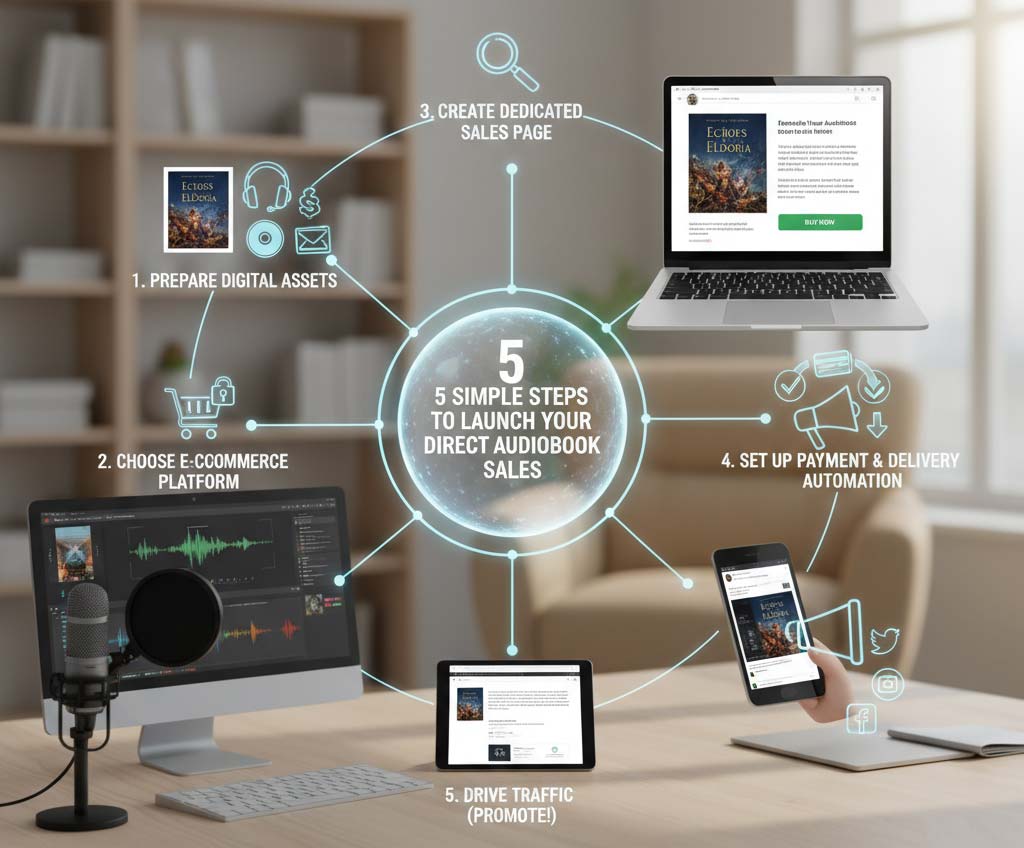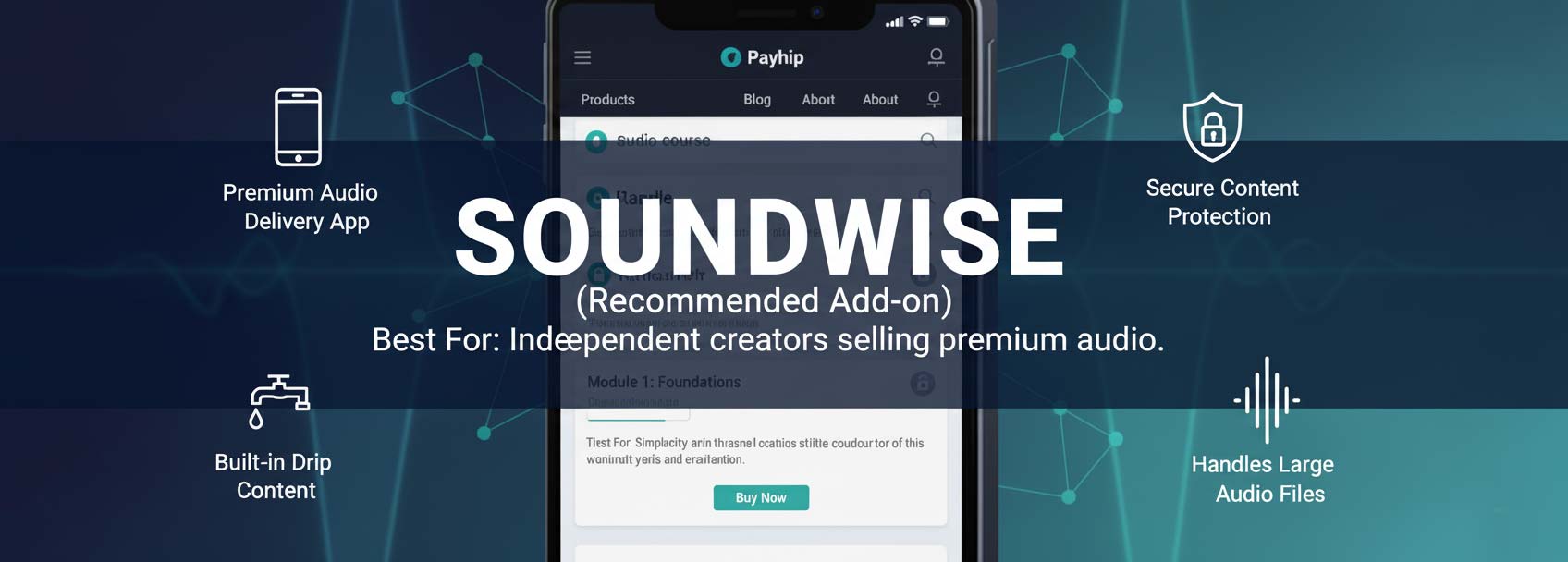The Simple Guide to Selling Your Audiobook Directly on Your Website
You’ve finished the hard work: your audiobook is recorded, edited, mastered, and ready for listeners. Now what?
While major retailers are an option, selling your audiobook directly on your website is a powerful move an author can make. But if the recording was the first hurdle, the next is knowing how to integrate a store on your site. There are some limitations with storefront providers, and choosing the right third-party services makes selling easy. This guide will simplify the process.
Direct sales means more control over pricing, direct access to your listeners, and, most importantly, up to 90%+ of the profit. It gives you instant flexibility, letting you quickly tailor sales and promotions for specific scenarios.
You can easily implement discounts, free offers, and other promotions on the fly at live events or set up a simple QR code purchase for attendees, all while bypassing slow traditional distribution. This simple guide will walk you through the essential steps, the best platforms, and the potential hurdles to help you start your direct sales journey today.
The Quality Foundation: Why Audiobook Technical Specs Still Matter
Even if you begin with direct sales, it is crucial to produce your audiobook following the strict technical specifications (loudness, bitrate, etc.) set by major retailers, such as Audible (ACX) or INaudio. Proactive adherence to these specs will guarantee your production meets all necessary requirements when you decide to bypass initial direct sales and pursue wider distribution.
If you recorded your own audiobook, it is highly recommended to consult with an audio editor or production company versed in preparing and modifying your finished audiobook to meet these necessary specs. Why?
- Professional Polish: Following these industry-wide standards guarantees a polished, professional end product that sounds great to your listener, regardless of where they download it.
- Future-Proofing: Adhering to these specs from day one ensures your audiobook is ready to meet the requirements of any major platform (ACX, INaudio, etc.) you choose to use for wider distribution in the future.
- Streamlined Distribution: You will avoid the time and hassle of modifying your final files to different shop specifications for upload and download across various retail platforms.
Don’t compromise on quality just because you’re selling direct.
5 Simple Steps to Launch Your Direct Audiobook Sales
 Selling direct doesn’t have to be complicated. Follow these five steps to set up your online storefront:
Selling direct doesn’t have to be complicated. Follow these five steps to set up your online storefront:
1. Prepare Your Digital Assets
Before you can sell, you need a perfect product. This includes:
- High-Quality Audio Files: Ensure your mastered audio is split into chapters (usually MP3 or M4B format).
- Cover Art: A high-resolution JPEG of your audiobook cover.
- Marketing Material: A short, enticing audio sample or a video clip to use on your sales page.
2. Choose Your E-commerce Platform
You need a system to securely host the large audio files, handle the payment, and automatically deliver the download link to your buyer. (See the platforms section below).
3. Create a Dedicated Sales Page
Build a clear, attractive product page on your website. This page should include:
- The audiobook cover art.
- A compelling synopsis.
- The audio sample.
- The purchase price and a prominent “Buy Now” button are linked to your chosen e-commerce platform.
4. Set Up Payment and Delivery Automation
Integrate your payment processor (like PayPal or Stripe) with your e-commerce platform. Test the process repeatedly to ensure that:
- The payment is correctly processed.
- The customer immediately receives a download link or access to a secure download page.
- 5. Drive the Traffic
5. Drive the Traffic (Promote your audiobook!)
Unlike major retailers that have built-in traffic, you are responsible for leading customers to your site. Promote your direct sales link everywhere:
- In your email newsletter.
- On all your social media channels.
- In the back matter of your print and eBook copies.
- Mention it in your author interviews and podcasts.
Platforms That Make Direct Sales Easy for Audiobooks
You don’t need to be a coding wizard to sell audiobooks directly. These platforms handle the technical heavy lifting for secure file delivery and payment (especially when contrasted with general e-commerce solutions):
1. Soundwise (Recommended Add-on)
- Best For: Independent creators and authors selling premium, private, or course-based audio content (e.g., audiobooks, courses, podcasts, training programs) directly to their audience.
Key Features:
- Premium Audio Delivery App: Provides a dedicated, white-labeled mobile app experience for listeners (iOS/Android), making content easy to consume without complex downloads.
- Secure Content Protection: Unlike simple download links, content is locked within the app, preventing piracy and unauthorized sharing of audio files.
- Handles Large Audio Files: Eliminates customer headaches related to large file sizes, slow downloads, or incompatible media players.
- Built-in Drip Content: Allows creators to release audio lessons or modules on a schedule (drip feed) for courses or programs.
2. Payhip
- Best For: Simplicity and secure file delivery.
Key Features:
- Quick Setup: You can create a fully functioning store in minutes without needing any coding knowledge or design skills. The interface is intuitive, making it easy to upload products and set prices.
- Minimalistic Storefront: The default store themes are clean and professional, focusing the customer’s attention on the products rather than complex navigation or distracting elements.
- Built-in Marketing Tools: It includes essential tools like affiliate systems, pay-what-you-want pricing, coupon codes, and an embedded checkout option for selling directly on an existing website (like a blog or portfolio) without complex integrations.
3. SendOwl
- Best For: Integrating seamlessly with existing websites (like WordPress or Squarespace).
Key Features:
- Seamless Website Integration: Easily embed ‘Buy Now’ buttons, product links, or a full shopping cart overlay onto almost any website, blog, or social media platform using simple code snippets.
- Secure Digital Delivery: Automatically and securely delivers digital files (like eBooks, music, and courses) via a unique, time-limited, and/or download-limited link sent to the buyer.
- Content Protection: Includes advanced features like PDF Stamping (stamping the buyer’s name/email on each PDF) and license key generation for software to deter unauthorized sharing.
- Recurring Revenue Tools: Fully supports selling subscriptions and memberships, making it ideal for course creators or recurring content publishers.
- Powerful Marketing Integrations: Built-in tools like one-click upsells/cross-sells, discount codes, cart abandonment recovery emails, and a dedicated affiliate program system to boost sales without extra software.
- Flexible Product Types: Supports a wide variety of digital goods, including e-books, software, audio, video, online courses (with content dripping), bundles, and even pay-what-you-want pricing.
4. Gumroad
- Best For: Quick setup and basic, minimalist file hosting.
Key Features:
- Simplicity and Speed: Its defining feature is its streamlined interface and super-fast setup. A creator can literally upload a file, set a price, and start selling within minutes.
- Minimalist Storefront: It provides a clean, hosted storefront page that is easy to link to, though it offers limited customization compared to platforms like Shopify.
- Audience Building: It includes built-in email marketing tools to help creators communicate with their customers and build a following.
- Affiliate Management: Creators can easily set up affiliate programs to let others promote their products for a commission.
- Platform Fees: Gumroad is known for a tiered fee structure that generally reduces the percentage it takes as a creator’s lifetime earnings grow.
Some Drawbacks of Using General E-commerce Storefronts for Audiobooks
While powerful platforms like WordPress or full-service options like Shopify offer broad flexibility, they introduce significant hurdles for audiobook authors who want to keep things simple:
-
Lack of a Native Audiobook Ecosystem: Platforms like Audible, Google Play, and Spotify are built specifically for selling and delivering audiobooks to the user with a clean app and interface. They handle the heavy lifting on file management, secure delivery, sales tracking, and royalty calculation. Many storefront providers, conversely, are primarily designed for physical goods; their digital selling capabilities are limited and often lack the native tools to sell audiobook stock as is. While self-hosting offers better royalties, integrating these essential features into your personal website and storefront requires a steep learning curve and constant maintenance.
-
Technical Complexity & Plugin Overload: Building a functional storefront on a powerful platform like WordPress requires significant coding knowledge and complex plugin implementation, which is a huge hurdle for authors just starting out.
-
File Size Limitations & Poor User Experience: Many general platforms (e.g., Shopify, WordPress, WooCommerce) severely limit digital uploads (often 20MB per file) on the front end. For WordPress, bypassing this limit often requires accessing the server via FTP, which demands technical knowledge. Since audiobooks are large, this file limit forces you to break the audio into many small chapters, preventing a clean M4B or zipped folder delivery, making the download process clunky and complex for the listener.
-
Requires Third-Party Delivery Platforms: These sites lack native support for handling large, secure digital file delivery necessary for audiobooks. Using a third-party platform like BookFunnel or Soundwise as an add-on to your current store option is fast and simple, but it still adds a monthly cost and an extra layer of integration you must manage.
-
Complex Sales Tax Responsibilities: As the merchant of record, you are responsible for understanding and remitting sales tax in potentially hundreds of different US jurisdictions—a confusing and time-consuming task.
-
Not Designed for Books: The default themes and features are primarily built for physical goods (clothing, accessories), not for the unique needs of selling digital books.
-
High Cost and Low Profit Potential: The combination of platform fees, transaction fees, and the recurring cost of required third-party apps can make it difficult to make a profit compared to specialized direct sales platforms.
-
Time and Support Burden: Authors must handle all customer service issues (refunds, download failures), which detracts from writing time and creates a significant time and stress burden.
How TravSonic Can Ensure Your Success

A successful direct-sale strategy hinges on a flawless, professional audiobook that immediately validates the listener’s purchase. TravSonic delivers that guarantee.
We transform your recorded audio into a commercially-ready product, allowing you to bypass production headaches and focus purely on profits. Give your listeners the best first experience:
-
Precision Audio Purification: We meticulously edit out all noise—breaths, pops, errors—and proof the final output for an uninterrupted, perfect performance.
-
Commercial Mastering Compliance: Our mastering guarantees your audiobook meets and exceeds all professional quality standards (ACX, INaudio, etc.), ensuring a technically brilliant, universally compatible listening experience.
-
Direct-Sale Technical Clarity: Get expert consultation on all specifications: file types, chapter divisions, and best practices for direct delivery.
-
E-Commerce Setup Support: Need help integrating your files with a delivery service or configuring your storefront? TravSonic assists with the technical backbone for smooth, automated customer downloads.
















